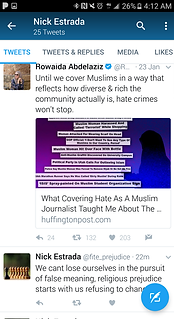
#stopreligiousprejudice
My campaign is created based upon my research on the portrayal of religion in the media. In my research it was discovered that the way people view religion lies heavily on media outlets such as the news, tv, and the movies. The portrayals effect from the media can cause a bias and give false representations of religion. My campaign was to end the bias and judgement that is pushed upon others. --genre proposal
Genres
I planed to post graphic images of people being persecuted based on their religion. For the most part racial prejudice is a result of how religion is portrayed in the media. I plan to use the media to do the opposite. I plan to use pathos to stir people’s emotions by showing them innocent people being persecuted. I also plan to break religious stereotypes by posting pictures of people within their respective religions doing normal stuff. My spoken word is used to send a more direct personal message to the audience. The three genres i used were Instagram, Twitter and a Video.






Video
Research Sources
The sources that I carried over from project 2 are “Rasmussen, Susan J. "Re-Casting The Veil: Situated Meanings Of Covering." Culture & Psychology 19.2 (2013): 237-258. Academic Search Complete. Web. 20 Feb. 2017”, “Winston, Diane. "Back To The Future: Religion, Politics, And The Media." American Quarterly 59.3 (2007): 969-989. Academic Search Complete. Web. 20 Feb. 2017.”, Tweed, Thomas A. "Why Are Buddhists So Nice?." Material Religion 4.1 (2008): 91-93. Academic Search Complete. Web. 20 Feb. 2017.”, “Tweed, Thomas A. "Why Are Buddhists So Nice?." Material Religion 4.1 (2008): 91-93. Academic Search Complete. Web. 20 Feb. 2017.”, and “Tan, Clara. "Media Ethics And The Coverage Of Islam: Some Preliminary Observations On The British Media." Intellectual Discourse 24.2 (2016): 295-317. Academic Search Complete. Web. 20 Feb. 2017.” I am choosing these sources because they cover specifically the false image religion that is presented in the media. Since my campaign seeks to stop racial prejudice I will be able to use the reasons why they are false judged to fix the problem. The sources cover the cultures of the religions and how they are drastically different then what people assume them to be. This will be extremely useful for my video because I’ll be able to create factual imagery about what the religions actually stand for.
Process Report
The name of my campaign was #stopreligiousprejudice, In my research from project 2 I learned that For the most part racial prejudice is a result of how religion is portrayed in the media. I had planned to use the media to do the opposite. I planned to use pathos to stir people’s emotions by showing them innocent people being persecuted. I also planned to break religious stereotypes by posting pictures of people within their respective religions doing normal stuff. The Genres that I used were Instragram, Twitter, and a Video. The intended audience was young adults, I had aimed to identify to young adults the preconceived opinions to which harms different cultures. The young adults include college students, high school students and adults that are social media savy. Young adults are the future however many people are lost and they continue to follow their same beliefs even though they nothing about it. The younger audience mostly teenagers and college students, live off of Instagram, Facebook and Twitter. The rhetorical strategy that I used was pathos as I used graphic images in my Instagram posts to stir the emotions of the audience, in one of my pictures it shows a Muslim woman standing in front of a graffitied building that read “go home Muslims” I also used Pathos in my spoken word, the music set a sad tone allowing me to get my point across. I reached out to a friend who was a director to help develop my spoken word. The director is also helping make a documentary for my organization. The Video was recorded on campus. I posted my Spoken word to YouTube as an outlet for my video and I pubbed my video through my Instagram page, and twitter page. To get people’s attention I reached out to the members of the organizations I associate my-self with through our group me’s and I was able to gain significant support from them. I also pubbed the video on my personal Social media pages and got people to share it on Facebook. I utilized Instagram, Twitter, Youtube, and Facebook, Youtube was used for people to view my spoken word while Facebook was used to share my Spoken Word. I posted my hashtag towards all forms of social media, it was the driving force of my campaign. Instagram was my most successful because people tend to use Instagram throughout the day, also I was able to gain a steady following from the people I personally reached out to. On Instagram I did not go on a following spree to gain followers I simply reached out to people from messages and sharing. On Twitter, I followed 444 people and I received 9 followers because twitter success is more contingent upon what specific tweets apply to the audience. Not everyone will agree to with the tweets. I have been promoting this genres throughout the month of April. I made a total of 20 posts for the Instagram account, the posts included political cartoons, graphic images, and memes. I used clever captions to convey my message to #stopreligiousprejudice. The composition process differed because I was able to apply what I learned about rhetoric to the research from Project 2 in order to create the campaign #stopreligiousprejudice Project 2 was pure research while in Project 3 I was able to actually create original work. I had to consider how I could most effectively promote my campaign within the given genres. For project 2 I had to find reliable sources develop a research project. The most challenging difference was having to creatively develop a campaign through genres that required a personal time and effort to be successful. The most challenging part about composing project 2 was collecting a significant amount of research and finding someone to interview for the project. Once the research was collected organizing and formulizing the work was the next step. I believe that I was effectively able to use my genres to push my campaign forward. The most effective genre was the video of my spoken word. The spoken word was inspired by my personal life experiences and my coming of age. Most people are lost in the views that have been pushed on them since birth. Children become adults while still clinging to a belief they know nothing about. The video director is Eugene Savitsky, he is an undergraduate at the Florida State University. Eugene has worked with me in the past such as the documentary that he is currently filming for my organization. I reached out to Eugene in the hopes that he would be able to see my vision. We were able to find a nice spot on campus and film. The reactions from people who saw the video were satisfactory. A Kid from my high school reached out to me saying “I’m not sure if you remember me, but we used to have art class together your sophomore year. I just watched your video, and I think its great. Keep doing what you are doing” what followed was a thumbs up emoji. That was my favorite reaction while most people told me how much they liked my video this one stuck out to me because I felt like I touched someone’s heart and made a difference. Although my campaign was made for the purpose of the classroom, it had actual applications to the real world. My campaign # stopreligousprejudice has a real meaning behind it and the content I was posting was meant to ensure that people understand that its a destructive issue in society. My spoken word video had 16 likes and around 80 views. Even though people didn’t click like it is clear to me that my video made an impact on other people’s lives. That’s why I believe this project was so important, it was more about using the skills learned from class to use rhetoric in order to convey your message to the public. This real world application provides a modernist twist to rhetoric.


